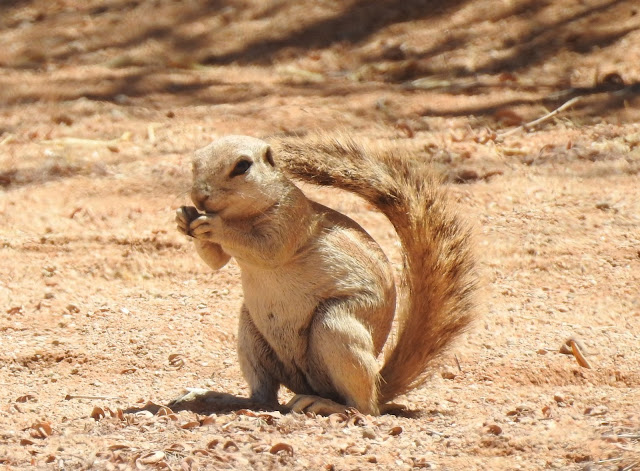Today we left Windhoek, after a quick trip to the pharmacy to get scripts and dressings for Jan. Before leaving we 'nearly' had an accident. A car swerved in front of our vehicle demanding emergency braking and many of our group were rattled, Karen receiving the worst of it with a bruised knee. Elago's reflexes were excellent as from my perspective, at the bus's front, a crash
Before long though we were driving south and then further west to the area of Namibia known as Sossusvlei. The drive started on bitumen but rather quickly turned to gravel. The surrounding countryside becoming noticeably drier as the drive continued. There were many things of interst though.
 |
| Agamas - sp? |
 |
| Add caption |
 |
| Sociable Weaver nest[s] atop a powerpole |
 |
| Lunch stop at Solitaire |
 |
| Cape Starling |
 |
| A social specie - South African Ground Squirrel |
 |
| White backed Mousebird |
 |
| Masked Weaver male at nest |
 |
| Marico Flycatcher |
 |
| Familiar Chat |
 |
| Cape Sparrow - male |
 |
| Cape Sparrow - female |
 |
| Yellow Mongoose |
 |
| Yellow Mongoose |
 |
| Yellow Mongoose |
 |
| Scaly Weaver |
 |
| Our first Oryx |
 |
| Oryx near our Desert Lodge |
 |
| Oryx or Gemsbok |
 |
| our Desert Lodge |
 |
| Lodge's dining & beer drinking area - a good spot for sundowners |
Sossusvlei (sometimes written Sossus Vlei) is a salt and clay pan surrounded by high red dunes, located in the southern part of the Namib Desert, in the Namib-Naukluft National Park of Namibia. The name "Sossusvlei" is often used in an extended meaning to refer to the surrounding area (including other neighbouring vleis such as Deadvlei and other high dunes), which is one of the major visitor attractions of Namibia.
The name "Sossusvlei" is of mixed origin and roughly means "dead-end marsh". Vlei is the Afrikaans word for "marsh", while "sossus" is Nama for "no return" or "dead end". Sossusvlei owes this name to the fact that it is an endorheic drainage basin (i.e., a drainage basin without outflows) for the ephemeral Tsauchab River. [from Wikipedia]
No comments:
Post a Comment